Category: Farm
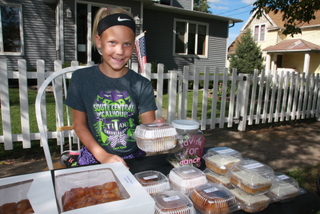
For the Love of Baking: Lake City’s Ellis Family Showcases Favorite Iowa Farm Recipes (Caramel Rolls, Pumpkin Bars and More!)
While some kids run lemonade stands, Tori Ellis, 11, sells homemade caramel rolls, pumpkins bars and more from a food stand in her family’s front yard along Main Street in Lake City. As she and her older sisters Aspen and Payton earn money for dance classes and dance competitions, they’re also learning the fine points of baking, using recipes passed on from their great-grandmother and grandmother.
“You k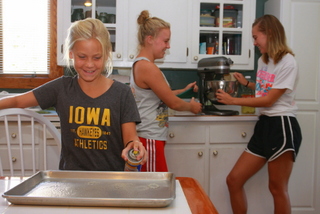 now it’s always good if you make it yourself,” said Aspen Ellis, 18, who is a senior at South Central Calhoun High School and reporter for the local FFA chapter.
now it’s always good if you make it yourself,” said Aspen Ellis, 18, who is a senior at South Central Calhoun High School and reporter for the local FFA chapter.
The Ellis girls learned to bake from their mother, Dannette (Smith) Ellis, who credits her mother, Jean, for teaching her learn how to cook. The Ellis family enjoy favorite recipes from the Smith and Schleisman sides of their family, including Grandma Loraine Schleisman’s famous caramel rolls and chocolate chip cookies. Other recipes, such as a creamy vanilla dessert and hearty beef stroganoff, are Dannette Ellis’ own creations. All have passed the Smith family’s “field test.”
“We take many of the things we make to the field at harvest or to the crew at our family’s hog barns,” said Dannette Ellis, whose girls get inspired by cooking shows like “Cake Boss” and “Good Eats” on TV.
Experimenting with new recipes is especially fun for Toi Ellis, who has sold homemade treats since she was seven years old. She’s glad her family bakes caramel rolls about every other week, since she has been known to sell 15 dozen in only three or four hours. “Baking makes the house smell like fall,” she said.
Savor more Iowa food history
Want more fun Iowa food stories and recipes? Check out my top-selling “Culinary History of Iowa” book from The History Press, and order your signed copy today.
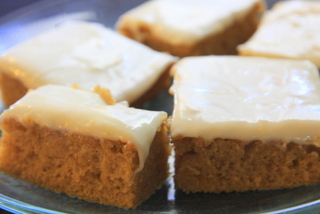
Dannette’s Pumpkin Bars
1 can pumpkin (or 2 cups fresh pumpkin)
2 cups flour
2 teaspoons baking powder
1 teaspoon baking soda
1 / 4 teaspoon salt
2 teaspoons cinnamon
2 cups granulated sugar
4 eggs
1 cup vegetable oil
1 teaspoon ground ginger
1 teaspoon pumpkin pie spice
Combine all ingredients. Bake in an 11-inch by 17-inch jellyroll pan for 20 minutes at 350 degrees. Frost with cream cheese frosting of your choice.
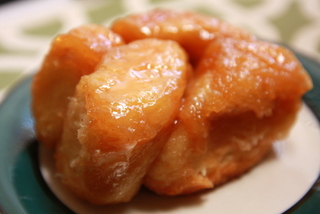
Grandma Schleisman’s Caramel Rolls
Don’t want to make caramel rolls? This recipe can also be used to make dinner rolls. Just don’t dip the knots of dough in a cinnamon-sugar mixture, and skip the caramel sauce.
2 cups granulated sugar
4 eggs
2 cups shortening or lard
3 teaspoons salt
1 cup mashed potatoes
1 teaspoon granulated sugar
4 packages yeast (2 1 / 4 teaspoons per package)
1 cup warm water, plus 5 cups warm water (or use potato water)
5 to 10 pounds flour
2 1 / 2 sticks of butter or margarine, melted
3 to 4 cups granulated sugar
Cinnamon, to taste
Mix together sugar, eggs, shortening, salt and mashed potatoes. (The Ellis family uses their large stand mixer for this process.) Set mixture aside.
Mix together 1 cup water, 1 teaspoon sugar and yeast in a glass bowl. Let mixture rise about 15 minutes.
Begin adding flour and water to mixture of sugar, eggs, shortening, salt and mashed potatoes. Add flour (a large spoonful at a time) and alternate with the 5 cups of warm water. Keep mixing and adding flour and water. When about half the water has been added to the dough, add the yeast water mixture. Continue to add flour and water until the water is gone and the dough begins to form a ball.
Turn the dough onto a floured surface. Knead the dough until it’s nice and smooth. Divide dough into two balls; place each one into large bowls that have been lightly greased with oil. Then cover each bowl with a damp towel.
Place bowls of dough in the warmest part of the house to let dough rise until it has doubled in size. Punch dough down. Cover bowls with a damp towel again. Let dough double in size once again.
Make the caramel topping (see recipe below). Pour caramel into 9-inch by 13-inch pans. (The caramel roll recipe makes 5 to 6 dozen caramel rolls. You can get 12 rolls into one 9-inch by 13-inch pan.)
In a bowl, combine the sugar and cinnamon. Melt butter or margarine in a separate bowl.
Punch down dough. Take a handful of dough and roll on the countertop. Form a strip of dough; then dip into the margarine and then into the cinnamon sugar. Tie dough into a knot. Place each knot on top of the caramel in the pan. Continue until dough is gone.
Bake each pan of rolls about 25 minutes, or until rolls are dark brown. The rolls need to be fairly dark on top in order for the middles of the rolls to bake properly. Cover rolls halfway through baking so the tops don’t get too dark. When baking is complete, let the rolls cool on the counter for about 2 minutes. Put tinfoil on top and flip pan over to invert. The pan should come off with no problem.
Let rolls cool. Store in air-tight plastic containers. Makes 5 to 6 dozen rolls.
Caramel Topping
2 / 3 cup brown sugar
1 / 4 cup margarine (Imperial brand margarine works well)
2 tablespoons corn syrup
Combine all ingredients in a sauce pan. Cook 1 minute, and then stir. Then cook 1 more minute. Pour mixture in bottoms of 9-inch by 13-inch pans.
Grandma Schleisman’s Famous Chocolate Chip Cookies
A mixture of shortening and butter help these cookies achieve the right shape and texture when baking.
1 1/3 cups shortening and butter (combine a mixture of roughly half butter and half shortening)
1 cup granulated sugar
1 cup brown sugar
2 eggs
2 teaspoons vanilla
3 cups flour
1 teaspoon baking soda
1 teaspoon salt
1 / 2 cup chocolate chips
Using a mixer, combine all ingredients except chocolate chips. Stir in chocolate chips by hand. Chill dough in refrigerator for 1 hour. Scoop out balls of dough onto baking stone or pan. Bake about 12 minutes at 350 degrees, or until cookies are nicely browned. Store cookies in air-tight container. These cookies freeze well, too.
Dannette’s Sugar Cookies
Almond extract adds a special flavor to these cookies, which work best when they are rolled out thin and are not overbaked.
1 cup margarine
1 1 / 2 cups powdered sugar
1 egg
1 teaspoon vanilla
1 / 2 teaspoon almond extract
2 1 / 2 cups flour
1 teaspoon baking soda
1 teaspoon cream of tartar
Cream margarine, powdered sugar, egg, vanilla and almond extract together until smooth. Add dry ingredients until well blended. Chill dough at least two hours, or overnight. Roll out dough on a floured surface to desired thickness. Cut dough with cookie cutters of your choice. Bake cookies on greased cookie sheet or baking stone at 350 degrees until bottoms and sides of cookies start to brown. Frost when cool.
Dannette’s Sugar Cookie Frosting
1 / 2 stick margarine
Dash of milk for right consistency
1 teaspoon almond extract
Powdered sugar (enough to make a nice, smooth frosting to coat the cookies)
Combine all ingredients together. Frost cookies, as desired.
Dannette’s Vanilla Dessert
This takes great on a crisp fall day with a warm cup of coffee.
1 / 2 cup walnuts
1 cup flour
1 / 2 cup margarine, melted
1 8-ounce contained whipped topping, reserve 1 cup
1 cup powdered sugar
1 8-ounce package cream cheese, softened
2 3-ounce packages instant pudding (any flavor is fine, although the Ellis family prefers vanilla)
3 cups milk
Chopped walnuts for garnish
For the first layer, combine walnuts, flour and margarine. Pat mixture into the bottom of a 9-inch by 13-inch pan. Bake 10 minutes at 375 degrees, and cool completely.
For the second layer, cream together 1 cup whipped topping, powdered sugar and cream cheese. Mix well. Spread over first layer in pan; chill.
For the third layer, combine pudding mixes and milk. Beat until thick. Pour pudding over second layer in pan; chill.
For the fourth layer, spread the remaining whipped topping over the third layer. Garnish with chopped walnuts. Refrigerate.
Dannette’s Beef Stroganoff
The Ellis family likes to serve this hearty stroganoff over mashed potatoes and cooked noodles.
2 pounds ground beef
1 / 2 cup chopped onion
3 cloves garlic
1 teaspoon beef bouillon
Salt, pepper, onion salt, garlic, meat tenderizer, to taste
1 can cream of mushroom soup
1 soup can of milk
1 / 2 cup sour cream
Brown ground beef in skillet. Drain fat. Add onion, garlic, beef bouillon, and seasonings. Cook until browned. Add cream of mushroom soup and milk. Cook for 5 minutes. When ready to serve, add sour cream.
I originally wrote this article for Farm News, Ft. Dodge, Iowa.
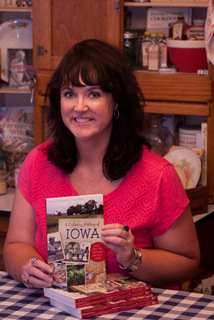
“A Culinary History of Iowa” Satisfies: Iowa History Journal Book Review
This terrific review of my latest book, “A Culinary History of Iowa: Sweet Corn, Pork Tenderloins, Maid-Rites and More,” from The History Press appeared in the September/October issue of Iowa History Journal. Enjoy!
Also, if you’d like to get your own signed copy of “A Culinary History of Iowa” or would like to send signed copies as gifts, click here to visit my online store. I appreciate your support for authors and Iowa-based small business!
Iowa has a long and substantial culinary history; far deeper than corn and pigs that are so often associated with our farm-rich state. “A Culinary History of Iowa,” written by Darcy Dougherty Maulsby, delves deep into its past, tracing as far back as the pioneer settlers for the story of food in Iowa.
From well-known names such as the Graziano Brothers, Blue Bunny ice cream and Maytag Blue Cheese, to hidden gems found in the most unexpected places, Iowa’s food culture is incredibly varied. As the book’s subtitle “Sweet Corn, Pork Tenderloins, Maid-Rites and More” suggests, there are unique flavors to be discovered across the state.
The book is an excellent primer on the roots of Iowa farmland, as well as current trends. Beginning with an overview of Iowa’s agricultural value and its products from American Indian traditions through the Great Depression and beyond, Maulsby concisely writes how Iowa history is tied to food creation, proliferation and consumption. The Iowa State Fair is a section unto itself, which befits the food-centric and beloved affair. A diverse gallery of local events (country fairs, sweet corn festivals) and modern confabs (Baconfest) are the beneficiaries of profiles, as well.
Finally, the book devotes space to the many long-established restaurants that can be found almost anywhere in Iowa; each with its own story to tell. It’s always fascinating to see history through a different lens, and Iowa’s culinary exploits definitely shine throughout these pages.
 Iowa has been influenced by many cultures in a variety of ways, but nowhere does that cultural melting pot shine so bright as in the kitchen. Polish, Swedish, German, Dutch and other culinary traditions are highlighted across multiple chapters in an exploration of what it means to be an immigrant in Iowa and how such cultures blend to create a far more ethnically diverse cuisine than many realize. Of all the observations and stories in the book, these wonderfully inclusive stories are among my favorites.
Iowa has been influenced by many cultures in a variety of ways, but nowhere does that cultural melting pot shine so bright as in the kitchen. Polish, Swedish, German, Dutch and other culinary traditions are highlighted across multiple chapters in an exploration of what it means to be an immigrant in Iowa and how such cultures blend to create a far more ethnically diverse cuisine than many realize. Of all the observations and stories in the book, these wonderfully inclusive stories are among my favorites.
This eclectic mixture of historical tidbits, social observations, vintage photos and delicious recipes provides just the right ingredients for a delightful reading experience. Maulsby, an Iowa native and lifelong food lover, has an obvious passion for her topic, and it pays off in this compact and charming book. She has worked across the state and Midwest for such diverse entities as Progressive Farmer magazine and the Iowa Turkey Federation.
Maulsby has written in many publications about Iowa food, and it’s clear that it is a labor of love and a collaborative labor as Maulsby solicited tales input from all across the state for the juiciest food-related tales and locations. Even those who are well acquainted with Iowa food lore are sure to find something new and interesting.
Ideal for anyone with a love of food history and particularly those with a Midwestern heart, this book has so many interesting tales, morsels of trivia and personal anecdotes that it feels as though the book should be twice as long. Go on an adventure with this fun, fascinating and tasty tale of culinary traditions that weave through Iowa’s past and present. Just be sure you have a snack handy.
(Julie Goodrich is a graduate of the University of Iowa and the University of Wisconsin. She works at Beaverdale Books in Des Moines, in addition to holding down a full-time job because she loves books.)
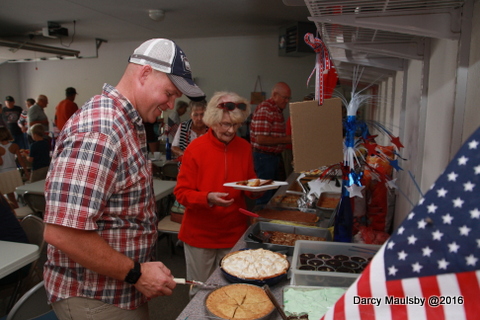
62 Years and Counting: Calhoun County, Iowa, Families Maintain 4th of July Picnic Tradition
Looking for deli fried chicken, bakery pies or other pre-made convenience food? Don’t be surprised if none of it turns up on the massive buffet on the Dial farm during the annual 4th of July picnic. I certainly didn’t see it at this year’s celebration.
“Everyone brings their A game to this event,” said Jolene Schleisman of Lake City, Iowa, who has been attending the 4th of July picnic since she was a child.
While my family has been attending the picnic each July for a few years, the event started in 1954 on Bud Burley’s farm near Lake City. Mike and Dorothy Nichols hosted the party the next year and maintained the tradition until 1981. Then their neighbors, Gerald and Alice Ann Dial, began hosting the celebration on their farm northwest of Lake City. In 2003, the event moved to the Dial’s son Dwight’s farm east of Lake City.
The celebration has been going strong ever since, attracting up to 50 or 60 guests each 4th of July. Along with the fireworks at dusk, the big attraction is the food. Countertops spanning the width of Dial’s two-car garage, along with additional tables, are loaded with homemade fried chicken, roast pork, casseroles, cheese potatoes, baked beans, salads of all kinds, deviled eggs, cakes, pies, candies and more.
“I appreciate how neighbors of all ages enjoy each other’s company,” said Laura Holm, a teacher from Ames who grew up on a farm near Lake City and brings her family back home for the picnic. “I also love the homemade, made-from-the-heart food that comes from friends’ kitchens, not store shelves. This party is about my roots, and I love to teach my kids about these roots.”
At this year’s celebration, Dial’s son, Andy, prepared a number of favorite recipes in honor of his late grandmother, Alice Ann Dial, including her famous lemon me
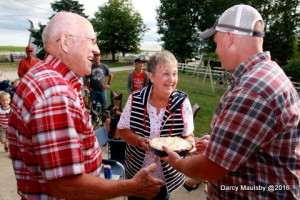
Andy Dial presents a lemon meringue pie to Jim and Joy Angove on their 50th wedding anniversary.
ringue pie. Schleisman also brought a number of classic dishes, including glazed ham balls. Oh yeah, that amazing Iowa classic that makes any picnic a little more memorable.
“To me and the Dial kids, the 4th of July picnic was better than Christmas,” Schleisman said. “I love it that this tradition continues.”
I couldn’t have said it better. Let’s eat!
Savor more Iowa food history
Want more fun Iowa food stories and recipes? Check out my top-selling “Culinary History of Iowa” book from The History Press, and order your signed copy today.
Fried Chicken
Andy Dial used his Grandma Alice Ann Dial’s recipe and his Grandma Dottie Loeck’s cast-iron skillet to make this fried chicken, which is always a star of the 4th of July picnic.
4 dozen chicken hind quarters separated into legs and thighs.
Breading:
5 cups all-purpose flour
1 1 / 2 teaspoons onion powder
1 cup whole wheat flour
1 tsp black pepper
4 tablespoons garlic salt
1 teaspoon paprika
2 tablespoons Lawry’s seasoning salt
Wash:
4 eggs
1 cup whole milk
Combine breading ingredients until mixed thoroughly. Place breading mix into a 9.5-inch pie pan. Beat eggs and milk together until mixed thoroughly. Place egg wash in a separate 9.5-inch pie pan.
Place chicken pieces first in the egg wash until liberally coated; then transfer to the breading mix and turn until coated fully. Once coated with breading, place chicken pieces into hot oil in frying pan. (Andy Dial prefers a cast-iron skillet.) Turn pieces ever 2 to 3 minutes until golden brown all over. Place into roaster pan at 350 degrees to finish cooking through and keep warm until serving time.
Note: To keep chicken crispy, serve immediately after frying.
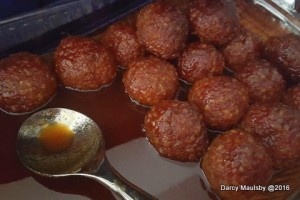
Glazed Ham Balls are an Iowa classic!
Glazed Ham Balls
Jolene Schleisman of Lake City uses 4 pounds of a ham-ball mix from the locker in Lake City to make these tasty ham balls. Her recipe shows how to make your own ham-ball meat mix, however. These ham balls can be made ahead and frozen (unglazed) to be baked later.
For the ham balls:
2 1 / 2 pounds ground ham
1 1 / 2 pounds ground pork
2 cups instant oatmeal or cracker crumbs
2 eggs, well beaten
1 cup milk
1 teaspoon ground pepper
For the glaze:
1 1 / 2 cups brown sugar
1 / 2 cup apple cider vinegar
1 teaspoon dry mustard
1 / 3 cup Cookies BBQ Sauce
1 / 2 cup water
2 tablespoons honey
Combine ground ham, ground pork, oatmeal or cracker crumbs, eggs, milk and pepper. Shape mixture into balls. Freeze the ham balls to bake later, or place them in a greased, glass baking dish.
To make the glaze, combine brown sugar, apple cider vinegar, dry mustard, BBQ sauce, water and honey in a saucepan. Cook over medium heat until sugar dissolves.
Pour glaze over ham balls. Bake for 1.5 to 2 hours at 275 or 300 degrees. About every 20 minutes, spoon the glaze over the ham balls as they bake. Yield: 32 ham balls
Deviled Eggs
Andy Dial used a recipe from his mother, Jane, to create this potluck favorite.
6 eggs
1 / 16 teaspoon pepper
2 tablespoons mayonnaise
1 / 4 teaspoon paprika
1 teaspoon vinegar
1 / 2 teaspoon dry mustard or 1 teaspoon prepared mustard
1 / 2 teaspoon salt
Slice hard-boiled eggs in half lengthwise. Remove yolks, smash and mix with seasonings. Refill egg whites with seasoned yolk mixture.
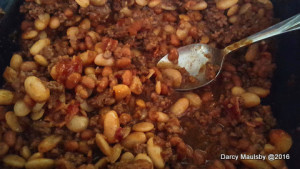
Calico Beans are healthy and always a hit at Iowa picnics.
Calico Beans
Jeanne Devine of Lake City brought along this potluck classic, which she created from a recipe on the Taste of Home website. This recipe can be easily doubled for a larger group.
4 ounces bacon, diced
1 pound lean ground beef (90% lean)
1 / 2 cup chopped onion
1 can (21 ounces) pork and beans
1 can (16 ounces) kidney beans, rinsed and drained
1 can (16 ounces) butter beans, rinsed and drained
1 / 2 cup packed brown sugar
1 / 2 cup ketchup
1 tablespoon cider vinegar
1 teaspoon prepared mustard
1 teaspoon salt
In a large skillet, cook bacon over medium heat until crisp. Remove to paper towels to drain. Discard drippings. In the same skillet, cook beef and onion over medium heat until the meat is no longer pink; drain. Combine the beef mixture, bacon, beans, brown sugar, ketchup, vinegar, mustard and salt. Spoon into a greased 2-quart baking dish.
Bake, uncovered, at 325 degrees for 45 to 60 minutes or until the beans are as thick as desired. Yield: 8-10 servings.
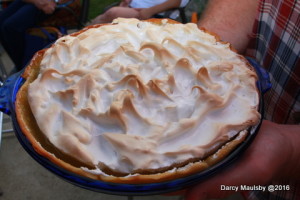
This homemade pie was inspired by Alice Ann Dial’s famous Lemon Meringue Pie.
Lemon Pie
Alice Ann Dial’s signature pie is distinguished by its fresh lemon flavor.
For the filling:
2 cups sugar
4 egg yolks
2 cups water
1 / 2 cup cornstarch
Dash of salt
8 tablespoons fresh lemon juice
2 tablespoons butter
For the meringue:
4 egg whites
8 tablespoons sugar
1 / 4 teaspoon cream of tartar
To mix the pie filling: Blend sugar, egg yolks, water, cornstarch and salt. Cook until the mixture thickens and bubbles up. Remove from heat and add lemon juice and butter. Pour the filling in a pre-baked pie shell made from Alice Ann’s all-purpose pastry mix (see recipe below) and cover immediately with meringue.
To make the meringue, beat the eggs whites until foamy. Add sugar and cream of tartar. Beat slowly until peaks form. Spread on pie, and bake the pie for 20 to 25 minutes at 325 degrees Fahrenheit.
All-Purpose Pastry Mix
Alice Ann Dial kept this all-purpose pastry mix on hand to save time when baking pie.
7 cups flour
4 teaspoons salt
2 cups lard
Combine all ingredients together to create a crumbled consistency, but make sure the mix doesn’t clump together. Store mixture in a covered container in the refrigerator.
For a single crust:
1 1 / 2 cups all-purpose pastry mix
3 tablespoons ice-cold water
For a double crust:
3 cups all-purpose pastry mix
5 tablespoons ice-cold water
Combine the all-purpose pastry mix and ice water until the mixture leaves the sides of the bowl. Then roll out the dough. If you’re making a pie shell for a lemon meringue pie, place the crust in a pie plate and prick the dough with a fork on the bottom and sides before baking the crust at 350 degrees Fahrenheit for 10 to 12 minutes.

Iowa Public TV’s “Market to Market” Features Expedition Yetter, Agri-Tourism, Des Moines Water Works’ Lawsuit
What do a water lawsuit, agri-tourism and good old Yetter, Iowa, (Everything’s Better in Yetter!) have in common? They are all part of my Expedition Yetter, which was filmed, in part, on my family’s Century Farm and featured on “Market to Market” on Iowa Public Television in the segment “Agri-Tourism in the Shadow of a Lawsuit.”
What fun we had, including Iowa Hawkeye football legend Chuck Long, who joined the group. Wonder what really goes on at an Iowa farm? Click here to watch the clip and ride along with the first-of-its-kind Expedition Yetter, which was designed to connect small-town and urban residents with the Iowa farms and agribusinesses where their food comes from.
Here’s a teaser from the show’s transcript:
Last year Iowa’s largest drinking water provider sued farm drainage districts in 3 counties upstream. As trial awaits in 2017, Des Moines Water Works has alleged excess nitrate runoff from farm fertilizers plagues efforts to comply with federal guidelines for safe drinking water. The utility claims cleaning the surface waters of the Raccoon River for half a million ratepayers in the capitol city vicinity has become an increasingly difficult and expensive task.
Bill Stowe/CEO and General Manager – Des Moines Water Works: “We’re very confident that these are clear point-source groundwater polluters that are coming from agricultural use.”
Ultimately, the case could redefine and broaden government jurisdiction over Waters of the United States – a prospect feared by many in farm country.
Darcy Maulsby/Expedition Yetter: “I’m not sure a lot of people in Iowa even knew where Calhoun County was before this lawsuit.”
Various producers, commodity groups, and politicians at the local and national level have called for widespread adoption of voluntary conservation methods to ward off new legislation.
But farmer and author Darcy Maulsby, who traces her lineage to a Century Farm near the small town of Yetter in one of the counties named in the lawsuit, hopes a dose of rural hospitality could mend fences.
Darcy Maulsby/Expedition Yetter: “I’ve noticed this growing trend towards this rift between rural Iowa and urban Iowa – and that really troubled me.”
Maulsby envisioned a journey bringing farm and city stakeholders together to help elevate the level of discourse. And after partnering with local non-profit Iowa Food & Family Project, the Iowa Soybean Association and several other food industry groups, tourists of diverse backgrounds loaded up in Des Moines early one summer morning for the maiden voyage of ‘Expedition Yetter.’
To read and watch the whole story, click here.
Explore more rural Iowa history
Want to discover more stories and pictures that showcase the unique history of small-town and rural Iowa? Perhaps you’d like a taste of Iowa’s culture and favorite recipes. Check out my top-selling “Culinary History of Iowa” book from The History Press and “Calhoun County” book from Arcadia Publishing, and order your signed copies today.
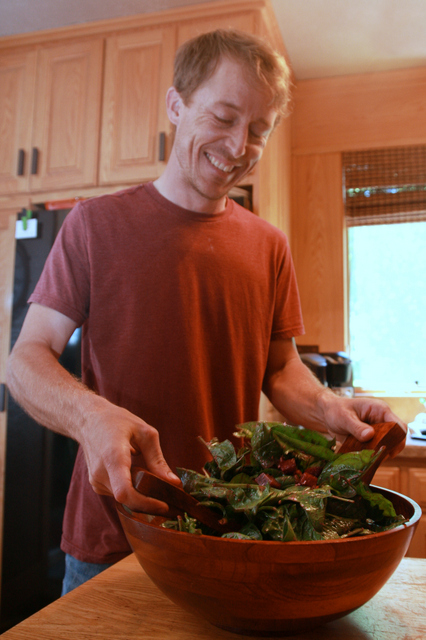
Very Veggie: Iowan’s Farm-Fresh Recipes Offer Guilt-Free Eating
For a guy who didn’t care for vegetables as a kid, Adam Nockels has come a long ways. Now he runs Iowa’s Raccoon Ridge Farm, which specializes in an array of naturally-grown produce.
“My foodie friends in college, including one who is a gardener, got me interested in fresh foods and new flavors,” said Nockels, who was born in Lake City but grew up on military bases before returning to the Lake City area.
Food production also appealed to Nockels, a U.S. Air Force veteran who used the G.I. Bill to attend Iowa State University, where he earned his biology degree in 2010. After completing an internship at Turtle Farm near Granger, where he learned about vegetable production and community supported agriculture (CSA), Nockels knew he wanted to work in production agriculture. When he proposed the idea of starting a farm on the land his family owns between Lake City and Auburn, his grandparents Dennis and Sheila Moulds liked the idea.
“My Grandma Sheila and my mom, Debby, have green thumbs,” said Nockels, who has 10 acres in Raccoon Ridge Farm, which includes 2.5 to 3 acres of vegetables grown with organic practices. “I also like working outdoors and growing healthy food for people.”
Nockels grows a wide variety of crops, including green beans, spinach, lettuce, radishes, strawberries, kale, herbs, squash, peas, potatoes, beets, heirloom tomatoes and more, which he sells at the Lake City Farmers Market and through his weekly CSA deliveries in Lake City, Rockwell City and Carroll. Nockels’ favorite heirloom tomato is the Cherokee Purple Tomato, a flavorful variety that was reportedly gifted to a farmer in Tennessee in the 1890s from Cherokee natives. “Nothing is better than an heirloom tomato,” Nockels said. “For me, it’s either slice, salt and go, or use the tomato in a BLT sandwich.”
Nockels’ weekly newsletters for CSA customers include a list of produce supplied that week, brief descriptions of the unique items in the box, tips for storing the produce, recipes and seasonal cooking tips such as how to roast chile peppers. Some of Nockels most popular items are his green beans. In 2015, the sandy, loamy soils of Raccoon Ridge Farm produced almost 450 pounds of green beans, so full-share holders received roughly 23 pounds of green beans each.
Nockels enjoys experimenting with new recipes, as well as relying on tried-and-true family recipes, to showcase the bounty of the harvest. “When good food is prepared properly, it tastes better. This is guilt-free eating.”
Savor more of Iowa and its food stories, history and more
Want more fun Iowa food stories and recipes? Sign up today for my blog updates and free e-newsletter, or click on the “Subscribe to newsletter” button at the top of my blog homepage.
You can also order my “Calhoun County” Iowa history book, postcards made from my favorite photos of rural Iowa and more at my online store. Thanks for visiting!
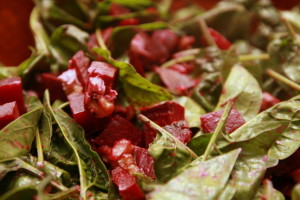
Roasted Beet Salad with Goat Cheese
1 / 4 cup balsamic vinegar
3 tablespoons shallots, thinly sliced
1 tablespoon honey
1/ 3 cup extra-virgin olive oil
Salt and freshly ground black pepper
6 medium beets, cooked and quartered
6 cups fresh greens (spinach, lettuce, arugula, etc.)
1 / 2 cup walnuts, toasted, coarsely chopped
3 ounces soft fresh goat cheese, coarsely crumbled
Line a baking sheet with tinfoil. Preheat oven to 450 degrees
Whisk the vinegar, shallots and honey in a medium bowl to blend. Gradually whisk in the olive oil. Season the vinaigrette to taste with salt and pepper. Toss the beets in a small bowl with enough dressing to coat. Place the beets on the prepared baking sheet, and roast until the beets are slightly caramelized, stirring occasionally, about 12 minutes. Set aside and cool.
Toss the greens and walnuts in a large bowl with enough vinaigrette to coat. Season the salad to taste with salt and pepper. Mound the salad atop four plates. Arrange beets around the salad. Sprinkle with goat cheese. Serve.
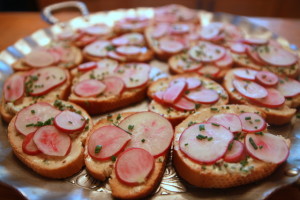
Radish Toast with Sesame-Ginger Butter
4 tablespoons butter, room temperature
3 tablespoons minced chives, divided
1 tablespoon toasted sesame seeds
3 / 4 teaspoon grated peeled fresh ginger
1 / 4 teaspoon Asian sesame oil
16 1 / 4-inch-thick baguette slices, lightly toasted
10 radishes, thinly sliced
Mix butter, 2 tablespoons chives, sesame seeds, ginger and sesame oil in small bowl; season with salt and pepper. Spread butter mixture over each bread slice. Top with radishes, overlapping slightly. Sprinkle with remaining chives.
Spinach Quiche
1 tablespoon butter
2 spring onions, minced
2 bunches spinach, thick stems removed and leaves roughly chopped
Coarse salt and ground pepper
4 ounces Gruyere or Swiss cheese, grated (about 1 cup)
1 frozen pie crust
4 large eggs
1 1 / 2 cups half-and-half
Dash of ground nutmeg
1 teaspoon salt
1 teaspoon pepper
Preheat oven to 350 degrees, with racks set in upper and lower thirds. In a large skillet, heat butter over medium. Add spring onions, and cook, stirring occasionally, until softened, 1 to 2 minutes. Add as much spinach to skillet as will fit; season with salt and pepper, and toss, adding more spinach as room becomes available, until wilted, 2 to 3 minutes.
Transfer spinach mixture to a colander. Press firmly with the back of a spoon to squeeze out as much liquid as possible. Sprinkle cheese onto crust. Spread spinach mixture over shredded cheese.
In a large bowl, whisk together eggs, half-and-half, nutmeg, 1 teaspoon salt and 1 teaspoon pepper. Pour egg mixture into crust.
Bake until center of quiche is just set, 55 to 60 minutes. Let quiche stand 15 minutes before serving.
Cover and refrigerate leftovers up to 1 day. Reheat at 350 degrees until warm in the center, 30 to 40 minutes.
Easy Kale Chips
Preheat oven to 350 degrees. Remove large central stem from kale leaves and tear into chip sized pieces. Drizzle with olive oil and add a sprinkle of salt or seasoned salt. Bake in the oven for 10-15 minutes until leaves edges are brown but not burnt.
Peas and New Potatoes
1 pound new potatoes
1 cup shelled peas
1 tablespoon butter
1 tablespoon flour
Salt and pepper to taste
1 cup milk or half & half
Bring a large pot of water to a boil over high heat. Boil potatoes for 15 to 20 minutes, until tender. Drain.
In a medium saucepan, bring 1 cup water to a boil. Simmer peas in boiling water for 6 to 7 minutes, or until tender (do not overcook). Drain.
Using the same saucepan, melt butter over medium heat. Stir in flour to make a thick paste; gradually whisk in milk, stirring constantly until slightly thickened. Season with salt and pepper to taste. Add potatoes and peas to the sauce; simmer for about 5 minutes, stirring often. Serve immediately.
Crisp Tuna-Cabbage Salad
One 5-ounce can tuna, drained
2 cups finely chopped green or red cabbage, from about 4 ounces or 1 / 4 of a small head of cabbage
1 tablespoon mayonnaise
3 tablespoons plain Greek yogurt
Salt and freshly ground black pepper
Shred the tuna with a fork and mix thoroughly with the cabbage. Stir in mayonnaise and yogurt. Add salt and pepper to taste. Eat immediately, or refrigerate for up to two days. Makes two 1-cup servings.
Basil Pesto
1-2 cups fresh basil leaves
2-4 cloves of garlic
3 / 4 cup good olive oil
1 / 2 cup grated Parmesan cheese
1 / 4 cup pine nuts or walnuts (opt.)
Put basil in blender or food processor. Add garlic, and blend, adding olive oil slowly. Add Parmesan and pine nuts. Blend all into a thick sauce.
This is good over any hot pastas. It can be also added to salad dressing, 1 tablespoon at a time, used as a spread for tomatoes, on crackers, etc. Pesto can also be frozen in small container for use later.
Green Bean and Pasta Salad
4 ounces penne pasta, uncooked (1 1/4 cups)
4 ounces green beans, halved crosswise (about 1 cup)
1 cup canned red or kidney beans, rinsed
1/4 cup chopped fresh flat-leaf parsley
2 tablespoons grated Parmesan (2 ounces)
2 tablespoons olive oil
2 tablespoons fresh lemon juice
Kosher salt and black pepper
Cook the pasta according to the package directions, adding the green beans during the last 3 minutes of cooking. Drain and run under cold water to cool.
Toss the cooled pasta and green beans with the red beans, parsley, Parmesan cheese, olive oil, lemon juice, 1 / 2 teaspoon kosher salt, and 1 / 4 teaspoon black pepper. Divide the salad between two containers and refrigerate for up to one day.
